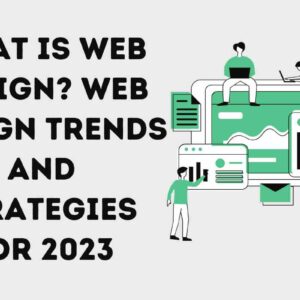Designing a website can be a daunting task for many, but with the right approach, it can be made easier. This ultimate guide to website design best practices helps you optimize performance and user experience so that your website looks and functions optimally.
We'll discuss the different ways you can use modern web technologies to make sure your site is fast, secure, and accessible. We'll also look at how good design principles like attention to detail and usability testing can improve user experience. With these tips in hand, you'll be able to create an effective website that performs well for both visitors and search engines.
What is Website Design and How Website design can help in Success for Any Business?
Website design is the process of creating a visually appealing and user-friendly website that meets the needs of your business. A good website design should attract visitors and keep them engaged while providing a great user experience. Website design is not just about aesthetics, it also involves coding, development, and optimization to make sure your website stands out from the competition. Website design can make or break your business - if it doesn't look professional and is difficult to navigate, customers may not stay on your site for long. This is why it's important to stay up-to-date with the latest website design trends and use a reputable website builder to ensure that your website looks great and functions well. By following web design tips, you can create an effective online presence that will help you reach more customers and grow your business.
Website design refers to the process of creating a visually appealing, user-friendly, and functional website that effectively communicates your brand message and supports your business goals. A poorly designed or managed website can turn customers away, while a well-designed website can enhance your business's reputation, generate more revenue and increase client retention.
Here's how website design can make or break your business:
- First Impressions: Your website is often the first impression customers have of your business. A well-designed website can capture their attention and make a positive first impression, while a poorly designed website can turn them away and hurt your credibility.
- User Experience: Website design is an essential part of doing business successfully in the digital era. A well-designed website can give your business a competitive edge and make it easier for potential customers to find you.
- Brand Perception: Your website design communicates your brand identity and values. A cohesive and professional design can build trust and credibility with customers, while a disjointed or unprofessional design can damage your brand image.
- Search Engine Optimization (SEO): A well-designed website can improve your search engine rankings, making it easier for customers to find you online. A poorly designed website with slow load times or broken links can hurt your SEO, making it harder for customers to find you.
- Mobile Compatibility: With more customers accessing the internet on mobile devices, it's essential to have a website design that's optimized for mobile use. A website that doesn't work well on mobile devices can hurt your business by driving away potential customers.
In summary, website design plays a critical role in the success of your business. A well-designed website can make a positive first impression, improve user experience, build brand perception, boost SEO rankings, and improve mobile compatibility. On the other hand, a poorly designed website can hurt your credibility, drive away potential customers, and damage your brand image. It's important to invest in professional website design to ensure that your website effectively communicates your brand message and supports your business goals.
Understanding the Basics of Effective Web Design & the Benefits of Doing it Right
Web design is an important element of any website, especially if you want your website to be successful. Effective web design is all about creating an engaging user experience that also looks great. It requires an understanding of the basics such as responsive design and mobile-friendly websites, as well as more advanced concepts like UX/UI design and user experience design.
By understanding the basics of effective web design and taking the time to get it right, businesses can unlock a range of benefits including increased customer engagement, improved search engine optimization (SEO), and better online visibility. In this article, we'll explore these aspects of web design in greater detail so you can understand why it's important and how to make sure your website looks its best.
Effective web design refers to the process of creating a website that not only looks visually appealing but is also user-friendly, easy to navigate, and optimized for search engines. Here are the basics of effective web design and the benefits of doing it right:
- Visual Appeal: Effective web design should be visually appealing and attract visitors' attention. It should incorporate an appropriate color scheme, typography, and imagery that align with your brand identity and values.
- User Experience (UX): Good web design prioritizes the user experience. A website should be simple, intuitive, useful, and easy to use. You shouldn't have to wonder how anything works or hunt around for the things you need and provide visitors with relevant and engaging content that encourages them to explore further. A good user experience will keep visitors engaged and encourage them to take desired actions such as filling out a form or making a purchase.
- Responsiveness: Effective web design should be responsive, meaning it is optimized for different screen sizes and devices. This ensures that visitors can access and navigate your website from any device, including desktops, laptops, tablets, and mobile phones.
- Search Engine Optimization (SEO): Good web design incorporates SEO best practices, including using relevant keywords in content and meta descriptions, optimizing page titles and URLs, and ensuring fast load times. This helps improve your website's ranking in search engines and increases the chances of your website being found by potential customers.
- Brand Consistency: Effective web design should reflect your brand identity and values. It should incorporate consistent branding elements such as logos, colors, and imagery to help reinforce your brand image and message.
Effective web design can lead to a number of benefits.:
- Improved User Experience: Effective web design makes it easy for visitors to navigate your website and find the information they need, leading to a better user experience.
- Increased Conversions: A good user experience can lead to increased conversions, such as sales or lead generation.
- Improved SEO: Effective web design incorporates SEO best practices, leading to improved search engine rankings and increased website traffic.
- Brand Perception: Consistent branding elements in web design help reinforce your brand identity and message, leading to a stronger brand perception.
- Competitive Advantage: Effective web design can give your business a competitive advantage by setting your website apart from competitors.
In summary, effective web design is critical to the success of your website and business. It improves the user experience, increases conversions, improves SEO rankings, reinforces your brand identity, and gives you a competitive advantage. Web design plays an important role in the success of many websites, which is why you should ensure that it's a part of your online strategy.
5 Strategies to Make Your Site Visually Appealing & Drive More Traffic
You can easily attract more visitors to your website by making it visually appealing. It's important to consider the visual elements of web page design such as layout, color palette, and typography. Here are five strategies to help you make your site more visually appealing and drive more traffic.
- Use Visuals Effectively: Use high-quality images and videos that align with your brand identity and message. Incorporate visuals that help break up text and make your website more engaging.
- Create a Clear Hierarchy: Use a clear hierarchy of information to help visitors navigate your website easily. Use headlines, subheadings, and bullet points to break up text and make it easier to read.
- Use White Space: Use white space effectively to help guide visitors' attention to important information and create a clean, uncluttered design. Too much information on a page can be overwhelming and turn visitors away.
- Choose an Appropriate Color Scheme: Use a color scheme that aligns with your brand identity and values. Color is key to establishing a sense of order. When used correctly, it can make your app more navigable and easy to understand.
- Ensure Responsiveness: Ensure that your website is responsive and optimized for different devices and screen sizes. Visitors should be able to access and navigate your website from any device, including desktops, laptops, tablets, and mobile phones.
By implementing these strategies, you can make your website visually appealing and improve the user experience, which can help drive more traffic to your site. It's important to remember that the design of your website is not just about aesthetics but also about usability and functionality. A visually appealing website that is difficult to navigate or doesn't function properly will not drive traffic or convert visitors into customers. Ensure that your website design is user-friendly, optimized for search engines, and aligned with your business goals.
How to Use SEO Techniques to Enhance Your Website Performance
Search Engine Optimization (SEO) is a set of best practices that improve how search engines index and display content on your website. This, in turn, makes it easier for people to find your content. Here are some SEO techniques to enhance your website performance:
- Keyword Research: Researching what people are actually searching for on the internet will help you learn more about your target market. Incorporate these keywords into your website content and metadata to help improve your search engine rankings.
- On-Page Optimization: Optimize your website's on-page elements such as titles, headings, URLs, and meta descriptions to help search engines understand the content on your site and improve your rankings.
- Content Creation: Create high-quality, relevant, and engaging content that aligns with your target audience's needs and interests. Use keywords strategically throughout your content and incorporate multimedia elements such as images and videos to make it more engaging.
- Link Building: Build high-quality backlinks to your website from other reputable websites to help improve your search engine rankings. This can be done through guest posting, social media sharing, and other link-building strategies.
- Mobile Optimization: Ensure that your website is optimized for mobile devices, as mobile optimization is a crucial factor in search engine rankings. This means that your website should be responsive, load quickly on mobile devices, and be easy to navigate on smaller screens.
- Analytics and Monitoring: Use analytics tools to monitor your website's performance and track your progress over time. Analyze data such as traffic sources, bounce rates, and user behavior to identify areas for improvement and adjust your SEO strategy accordingly.
By implementing these SEO techniques, you can enhance your website performance and improve your search engine rankings, leading to more organic traffic and better business outcomes. However, it's important to remember that SEO is a long-term strategy that requires ongoing effort and optimization to see results.
Exploring Advanced Web Design Techniques To Create Interactive Experiences That Keep Visitors Engaged
Advanced web design techniques can help create interactive experiences that keep visitors engaged and interested in your website. Here are some techniques you can use:
- Animation and Effects: Animations and effects can add an element of interactivity and engagement to your website. Consider using parallax scrolling, hover effects, or animations to draw attention to important content and create a more dynamic user experience.
- Interactive Forms: Use interactive forms to collect user data and engage visitors. Consider adding features such as auto-complete, real-time validation, or progress bars to make filling out forms more engaging.
- Dynamic Content: Use dynamic content to personalize the user experience and keep visitors engaged. This could include features such as personalized recommendations, related content, or user-generated content.
- Gamification: Use game-like elements such as badges, points, or leaderboards to encourage user engagement and create a more interactive experience.
- Chatbots: Implement chatbots to provide instant support and engage visitors in conversation. Chatbots can help visitors find what they're looking for, answer common questions, and provide personalized recommendations.
- Video Backgrounds: Use video backgrounds to create a more immersive experience and draw visitors in. Video backgrounds can be used to showcase products or services, provide a sense of atmosphere, or tell a brand story.
By using these advanced web design techniques, you can create a more interactive and engaging experience for your visitors. It's important to keep in mind that these techniques should be used strategically and in moderation, as too much interactivity or distraction can detract from the user experience. Ultimately, the goal of any advanced web design technique should be to enhance the user experience and help visitors achieve their goals on your website.





